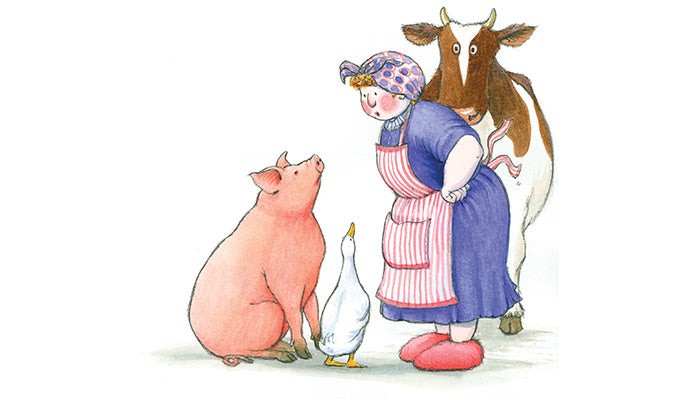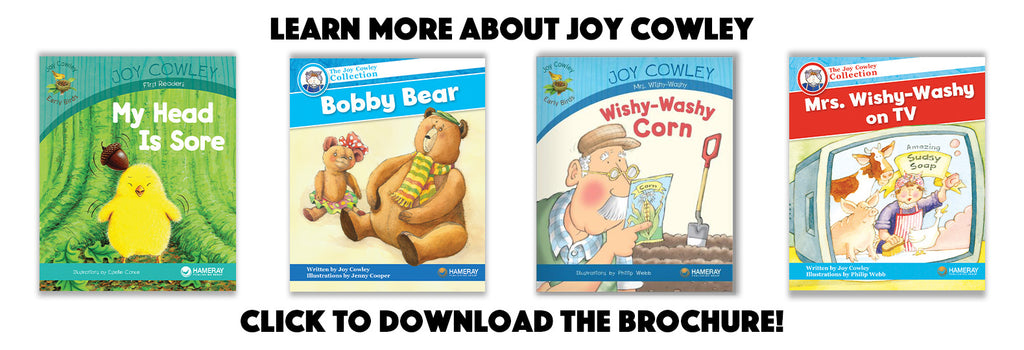Editor's Note: This blog was previously published, we're re-sharing it as part of our 'Best of' series, a look back at some of our most popular blogs.
This is a guest post from blogger Becca Ross.
If you teach Pre-K through 2nd grade, I'm sure you're familiar with the beloved Mrs. Wishy-Washy. Twenty years ago, when I first started teaching, I had many of the Mrs. Wishy-Washy books. I had big books for whole class lessons and six-packs for small group instruction. Many of the books were purchased with a grant from the school, so when I moved schools, I couldn't take the books with me. My new school didn't have the Mrs. Wishy-Washy titles, so I started looking for them online. Much to my dismay, the company that I had purchased them from previously had been bought by another company, and I couldn't find the books! For the past several years, I've been teaching with the few Mrs. Wishy-Washy and Meanies books that I own. (If you aren't familiar with the Meanies books, Mrs. Wishy-Washy makes a cameo appearance.) One day, I was browsing through some of my favorite literacy blogs and spotted a post about Mrs. Wishy-Washy! The books looked slightly different than my 20-year-old copies and appeared to have a new publisher, but I was THRILLED to have found my favorite character again! Now I get to tell you all about why I love Mrs. Wishy-Washy! The book that I would like to share with you today is called Mrs. Wishy-Washy and the Big Wash, written by Joy Cowley and illustrated by Elizabeth Fuller-Fulton. I'll start by telling you about the story: Mrs. Wishy-Washy is a bit obsessed with cleanliness. She likes things just-so. When it was time for the farm animals' “wash day,” she was out of water, and they had to search the town to find some. Now that you have an idea of what the book is about, let's get to how I like to use these titles for guided reading!
For the past several years, I've been teaching with the few Mrs. Wishy-Washy and Meanies books that I own. (If you aren't familiar with the Meanies books, Mrs. Wishy-Washy makes a cameo appearance.) One day, I was browsing through some of my favorite literacy blogs and spotted a post about Mrs. Wishy-Washy! The books looked slightly different than my 20-year-old copies and appeared to have a new publisher, but I was THRILLED to have found my favorite character again! Now I get to tell you all about why I love Mrs. Wishy-Washy! The book that I would like to share with you today is called Mrs. Wishy-Washy and the Big Wash, written by Joy Cowley and illustrated by Elizabeth Fuller-Fulton. I'll start by telling you about the story: Mrs. Wishy-Washy is a bit obsessed with cleanliness. She likes things just-so. When it was time for the farm animals' “wash day,” she was out of water, and they had to search the town to find some. Now that you have an idea of what the book is about, let's get to how I like to use these titles for guided reading!
5 Ways to Use Mrs. Wishy-Washy for Guided Reading:
 1. Onomatopoeia I chose this book as my first to share with you because my kindergarten students absolutely LOVE onomatopoeia, and I knew this would be a favorite. If you aren't familiar with onomatopoeia, it refers to “the naming of a thing or action by a vocal imitation of a sound associated with it” (Merriam-Webster). It's a game-changer when introduced during kindergarten Writer's Workshop. Students love adding "sound words" to their writing, and I suspect that they love saying the word “onomatopoeia” every time they notice it being used in a story.
1. Onomatopoeia I chose this book as my first to share with you because my kindergarten students absolutely LOVE onomatopoeia, and I knew this would be a favorite. If you aren't familiar with onomatopoeia, it refers to “the naming of a thing or action by a vocal imitation of a sound associated with it” (Merriam-Webster). It's a game-changer when introduced during kindergarten Writer's Workshop. Students love adding "sound words" to their writing, and I suspect that they love saying the word “onomatopoeia” every time they notice it being used in a story.
2.
 Teacher’s Notes
Teacher’s Notes
Another great thing about this book is that it has “Teacher Notes” at the back... hello, Guided Reading groups! The back page of the book gives the teacher suggestions for before, during, and after reading, and also has suggestions for making meaning, analyzing the text, and taking things to the next level. They call this Cracking the Code and point out rhyming and compound words. In my previous school district, we had an entire room dedicated to storing our Guided Reading books. Unfortunately, my new district does not have the same resources. Last spring, I described the steps of a Guided Reading lesson to a teaching partner, and we wished our books had a tool like this embedded into them.
3. Group Lessons
I'll tell you a couple of different ways I would use this book in my ideal world. I love using big books in my classroom because kids can actually see the text and the illustrations,
 even if they are sitting at the back of the rug. One way to use this would be to do a whole group lesson with the big book version of the story. I would still use some of the before, during, and after reading ideas, but spread it out over 3-5 days of instruction. I love reading half of the book on the first day and saving the other half for the second day. Kids absolutely beg for the second half of the story! By day 5, most of the kids are reading along with the big book, and they are also able to read it on their own during our literacy stations.
even if they are sitting at the back of the rug. One way to use this would be to do a whole group lesson with the big book version of the story. I would still use some of the before, during, and after reading ideas, but spread it out over 3-5 days of instruction. I love reading half of the book on the first day and saving the other half for the second day. Kids absolutely beg for the second half of the story! By day 5, most of the kids are reading along with the big book, and they are also able to read it on their own during our literacy stations.
4. Guided Reading Groups Another option for using this book, in my ideal world, would be to purchase six-packs of the small versions of the books to have on hand for Guided Reading groups. The before, during, and after reading Teacher Notes at the back are set up perfectly for small group instruction.
5. Other Text Features Any way you read this book, I love the text features you can point out. Punctuation, rhyming words, onomatopoeia, and compound words are part of our everyday instruction in kindergarten.

I'm so happy that I've found Mrs. Wishy-Washy again, and can once again share her magic with my Kindergarten students!
This is a guest blog post by Becca Ross, who usually writes over at Love, Laughter, and Literacy. To read more from her, come back here often for more posts from her, or check out her blog!
~~~
Download our brochure and learn more about the variety of Joy Cowley titles that you can incorporate in your classroom below! Every Joy Cowley story will capture the hearts and minds of young readers with the magic of Joy's signature 'learning through laughter' storytelling style.







